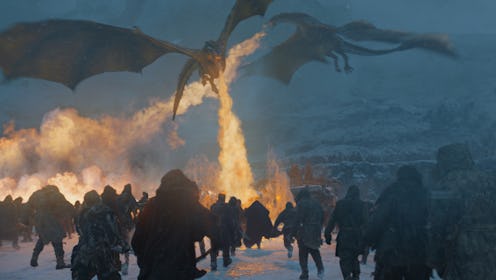
For years, fans have been speculating about the introduction of an ice dragon, whether it was hibernating beneath the crypts of Winterfell or frozen inside the Wall. The most recent episode, "Beyond The Wall," seemed to deliver on that promise, turning Viserion into an ice dragon on Game Of Thrones… or did it? Upon watching the Night King place his hand on Viserion's snout and seeing the dragon's piercing-blue eye snap open, you of course assumed that the undead beastie was about to get up and start spewing ice everywhere. But is that really how it works? George R.R. Martin would beg to disagree.
In his A Song Of Ice And Fire series, there are two distinct kinds of dragons. The most prevalent and well-known kind are the fire-breathing dragons that hail from Old Valyria; the inhabitants of that old empire used to tame them and ride around on their backs like giant, terrifying horses. But after the ambiguous cataclysm known only as the Doom of Valyria, the only survivors were a minor House known as the Targaryens and the handful of dragons they owned. Eventually, even those dragons died out, until the only remnants of the species were three fossilized eggs found in Asshai and given to Daenerys as a wedding gift, which she later managed to hatch in a blood magic ritual.
While those scaly, fiery beasts are the first thing that most people think of when they hear "dragon," there's also a second species in Martin's fantasy world known as ice dragons. While the fire dragons originated in Valyria, the ice dragons make their home in the frozen wastes of the Shivering Sea, the inhospitable expanse of water that runs east of Westeros and north of Essos. The ice dragons are the stuff of legends, figuring into the scary stories Old Nan used to tell the Stark boys; they're said to be many times larger than the Valyrian fire dragons, literally made of ice, with pale blue eyes like crystal and breath so cold it will freeze anyone in its path.
So, to be clear: fire dragons and ice dragons are two very different breeds, and killing one kind and raising it as a wight won't suddenly transform it into the other kind. Nothing Thrones has shown the viewer in the past seven seasons indicates that the Night King has any transformative power other than the ability to reanimate dead flesh and enthrall it under his mind control. Although Viserion is now a wight, he's still essentially Viserion. The fact that his corpse has been raised by the Night King shouldn't mean that he suddenly has the ability to spew ice instead of fire… and, if he does, then the show will have some serious explaining to do.
However, I don't mean to rain on anybody's ice dragon parade. While that would undoubtedly be cool, the reality of a fire-breathing dragon under the Night King's control is nothing to scoff at, either. In the world of Thrones, dragons of any kind are basically nuclear weapons; it's like bringing a high-tech military drone to a caveman's rock fight. Now, in the Great War to come, Dany and her remaining two dragons won't just have to be dodging ice spears from the Night King and scorpion missiles from Queen Cersei; they'll also have to be dodging a flame-spewing jet plane.
And the fact that the wight-dragon used to be Viserion, one of Dany's beloved "children," will probably make it even harder for her to kill it when she inevitably faces off against it in the future. (Think of the way characters in zombie movies always hesitate before shooting when they see the reanimated corpses of their loved ones… often to their own doom)
But the biggest advantage a wight-dragon gives the Night King — compared to what an ice dragon would offer — is the potential to finally get past the Wall, the final obstacle standing between his army and the rest of Westeros. Fans have theorized for years about how the Wall would finally fall. In the books, there's a mythical artifact known as the Horn of Winter that could have the potential to send the Wall topping down, but it's never even been mentioned on the show. Viewers thought the Night King's mark on Bran might result in a breaking of the Wall's enchantments when Bran passed through earlier this season; but, if that happened, it wasn't communicated onscreen in any way.
However, do you know what melts ice? Fire. (Conversely, do you know what doesn't melt ice? More ice.) With a fire-breathing wight-dragon at his disposal, the Night King should finally be able to destroy the one barrier that's been holding him back, allowing the army of the undead to sweep over Westeros, obliterating everything in its path. An ice dragon may sound cool in theory, but it would be pretty useless when it came to melting the Wall; it would only end up adding to its prodigious height.
So while some fans may mourn the missed opportunity to see an ice dragon in action, a wight-dragon is ultimately an even more powerful weapon for the Night King to have under his control… and should make for some agonizing and suspenseful battles to come in Thrones' final season.